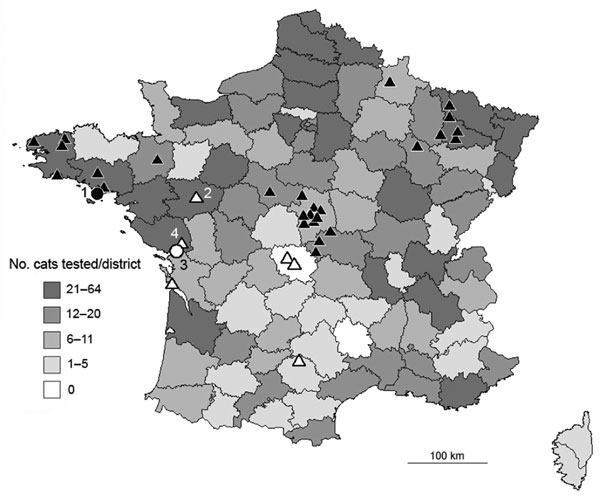European Bat Lyssavirus Transmission among Cats, Europe
Laurent Dacheux

, Florence Larrous, Alexandra Mailles, Didier Boisseleau, Olivier Delmas, Charlotte Biron, Christiane Bouchier, Isabelle Capek, Michel Muller, Frédéric Ilari, Tanguy Lefranc, François Raffi, Maryvonne Goudal, and Hervé Bourhy
Author affiliations: Institut Pasteur, Paris, France (L. Dacheux, F. Larrous, O. Delmas, C. Bouchier, M. Goudal, H. Bourhy); Institut de Veille Sanitaire, Saint-Maurice, France (A. Mailles, I. Capek); Direction Départementale des Services Vétérinaires de la Vendée, La Roche-sur-Yon, France (D. Boisseleau); Centre Hospitalier Universitaire de Nantes, Nantes, France (C. Biron, F. Raffi); Clinique Vétérinaire du Bas-Poitou, Fontenay-le-Comte, France (M. Muller); Clinique Vétérinaire Roosevelt, Vannes, France (F. Ilari, T. Lefranc)
Main Article
Figure 2

Figure 2. Distribution of cats analyzed during 2004–2007 and of bats found positive for European bat lyssavirus (EBLV) in France during 1989–2007. Distribution of 1,506 cats tested during 2004–2007 by direct immunofluorescence antibody test, rabies tissue culture infection test, and an antigen-capture ELISA is given by district. Precise location of the 2 infected index (positive) cats and positive bats (n = 32) are indicated by circles and triangles, respectively, and associated with numbers 1, 2, 3, and 4 for isolates 03011FRA, 03002FRA, 07240FRA, and 08120FRA, respectively. EBLV-1a and EBLV-1b isolates are indicated in black and white, respectively. Map was constructed by using Articque’s C&D software (www.articque.com) and published according to Articque's publication policy.
Main Article
Page created: December 08, 2010
Page updated: December 08, 2010
Page reviewed: December 08, 2010
The conclusions, findings, and opinions expressed by authors contributing to this journal do not necessarily reflect the official position of the U.S. Department of Health and Human Services, the Public Health Service, the Centers for Disease Control and Prevention, or the authors' affiliated institutions. Use of trade names is for identification only and does not imply endorsement by any of the groups named above.
